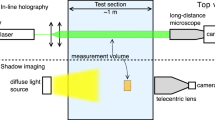Abstract
In-line digital particle holography is applied to measure the characteristics of spray droplets. Common reconstruction methods were considered and the best one was selected. Several important parameters at the time of hologram recording, such as the object distance and the region of laser beam used, are discussed. The feasibility of the correlation coefficient (CC) method for focal plane determination of 3-D droplets was verified. A double exposure hologram recording system with synchronization system for time control was established, and two digital spray holograms were obtained in a short time interval. For post-processing of reconstruction images, the two-threshold and the image segmentation methods were used in binary image transformation. Using the CC method and some image processing techniques applied to droplets in each double exposure image, the spatial positions of droplets used to evaluate the three dimensional droplet velocities were easily located, which proved the feasibility of in-line digital particle holographic technology as a good measurement tool for spray droplets.
Similar content being viewed by others
References
U. Schnars and W. Jueptner, Digital Holography, Springer, Berlin, Germany, (2005).
M. Jaquot, P. Sandoz and G. Tribilon, High resolution digital holography, Optics Communications. 190(1) (2001) 87–94.
S. Lai, B. Kemper and G. V. Bally, Off-axis reconstruction of in-line holograms for twin-image elimination. Optics Communications. 169(1) (1999) 37–43.
H. Wang, D. Wang, J. Xie and S. Tao, Recording conditions of digital holography, Proc. of International Congress on High-Speed Photography and Photonics, SPIE, Bellingham, WA, USA. (2007) 62791J-1∼10.
J. Kim, J. Chu and S. Lee, Improvement of pattern recognition algorithm for drop size measurement, Atomization and Sprays. 9(3) (1999) 313–329.
K. J. Hay, Z. C. Liu and T. J. Hanratty, A backlighted imaging technique for particle size measurement in two-phase flows, Experiments in Fluids. 25(3) (1998) 226–232.
L. Yu and L. Cai, Iterative algorithm with a constraint condition for numerical reconstruction of three-dimensional object from its hologram, J. Opt. Soc. Am. A. 18(5) (2001) 1033–1045.
F. Dubois, C. Schockaert, N. Callens and C. Yourassowsky, Focus plane detection criteria in digital holography microscopy by amplitude analysis, Opt. Express. 14(13) (2006) 5895–5980.
C. B. Lefebvre, S. Coetmellec, D. Lebrun and C. Ozkul, Application of wavelet transform to hologram analysis: three-dimensional location of particles, Opt. Laser Eng. 33(6) (2000) 409–421.
Y. Zhang, D. X. Zheng, J. L. Shen and C. L. Zhang, 3D locations of the object directly from inline holograms using the Gabor transform, Proc. of Holography, Diffractive Optics, and Applications II, SPIE, Bellingham, WA, USA. (5636) (2005) 116–120.
Y. Yang, B. S. Kang and Y. J. Choo, Application of the correlation coefficient method for determination of the focal plane to digital particle holography, Applied Optics. 47(6) (2008) 817–824.
Y. J. Choo and B. S. Kang, The characteristics of the particle position along an optical axis in particle holography, Meas. Sci. Technol. 17(4) (2006) 761–770.
A. Macovsk, Spatial and temporal analysis of scanned systems, Applied Optics. 9(8) (1970) 1906–1910.
S. J. Baek and S. J. Lee, A new two-frame particle tracking algorithm using match probability, Experiments in Fluids. 22(1) (1996) 23–30.
The Expression of Uncertainty and Confidence in Measurement, United Kingdom Accreditation Service, M 3003, Edition 2, (2007) 16–36.
Author information
Authors and Affiliations
Corresponding author
Additional information
This paper was recommended for publication in revised form by Associate Editor Gihun Son
Boseon Kang received his B.S. and M.S. degrees in Mechanical Engineering from Seoul National University in 1986 and 1988, respectively. He then went on to receive his Ph.D. degree from University of Illinois, Chicago in 1995. He is currently Professor at School of Mechanical Systems Engineering, Chonnam National University in Gwangju, Korea. His research interests are in the area of sprays, holographic techniques in thermofluid measurements.
Yan Yang received his B.S. degree in Mechanical Engineering from Chongqing Insitute of Technology in 1997, and received his M.S. degree in Mechanics from Chongqing University in 2005. He is doctoral student of Department of Mechanical Systems Engineering, Chonnam National University in Gwangju, Korea. He is also currently Associate Professor at Automobile College, Chongqing University of Technology in Chongqing, China. His research direction is digital holographic techniques
Rights and permissions
About this article
Cite this article
Yang, Y., Kang, B. Measurements of the characteristics of spray droplets using in-line digital particle holography. J Mech Sci Technol 23, 1670–1679 (2009). https://doi.org/10.1007/s12206-009-0417-1
Received:
Revised:
Accepted:
Published:
Issue Date:
DOI: https://doi.org/10.1007/s12206-009-0417-1




